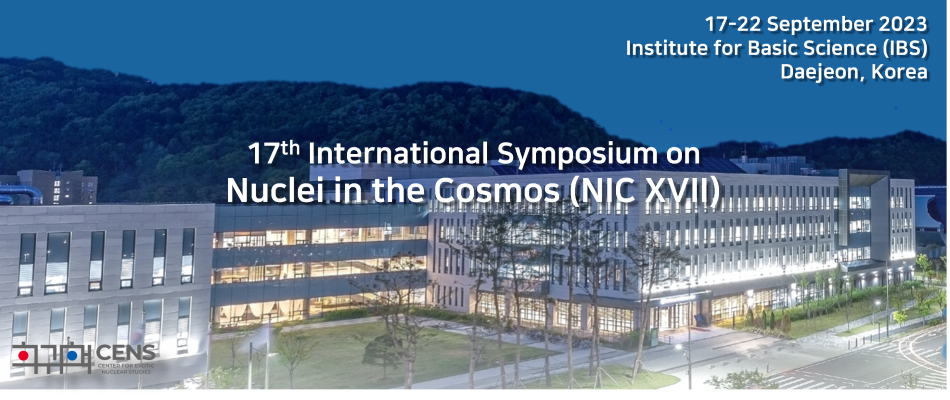One of the goals of nuclear astrophysics is to understand the various astrophysical events occurring in the cosmos.
The most common stellar explosions observed in our galaxy are Type I X-ray bursts (XRB1).
The isotopic abundances obtained from the astrophysical models of XRB1 depend strongly on a number of nuclear reaction rates, occurring both on the surface and inside the crust by the...
The 15O(α, γ)19Ne and 18F(p, α)15O reaction rates at stellar temperatures have significant impacts on the dynamics in x-ray bursts, novae explosions, and heavy element synthesis. Due to its importance, the nuclear structure of the compound nucleus 19Ne, which determines the reaction rate, has been widely investigated. Collecting the available data from experimental measurements, Nesaraja et...
The study of the $^{26}$Si($\alpha$,$p$)$^{29}$P reaction rate is essential for understanding X-ray burst phenomena. It is believed that the heavy elements up to the Sn-Sb-Te region can be synthesized during the burst. Since 26Si is considered to be a waiting point during the burst, the $^{26}$Si($\alpha$,$p$)$^{29}$P reaction rate is believed to be one of the most significant reactions that...
Developments of the rare beam acceleration have opened new opportunities for study of mirror resonance reactions. Namely, comparison of the results of the mirror resonance reactions gives the opportunity to understand nuclear structure deeper.
$\quad$ Understanding the nuclear structure of $^{19}F$ and $^{19}Ne$ is crucial in comprehending the clustering structure around mass $A=20$. ...
14O(α,p)17F is one of the important reactions that strongly affects the light curves of Type Ⅰ X-ray burst models [1]. The reaction rate is known to determine the break-out path from the hot CNO cycle to the rp-process at sufficiently high temperatures (T9 > 0.5) [2]. However, its large uncertainty due to the lack of experimental measurements causes difficulties in the precise demonstration of...
In the X-ray bursts, the ${}^{26}$Si($\alpha$, p)${}^{29}$P reaction rate is considered to have a great impact on the light curve. However, there were insufficient experimental data for this reaction because of technical difficulties. In order to measure the cross section of the reaction, a direct measurement was performed at the CNS RI beam separator (CRIB). CRIB produced a ${}^{26}$Si beam...
Classical novae are common cataclysmic events in the Galaxy involving a binary system. In the early Galaxy these explosions proceeded differently, mainly due to the accretion of sub-solar material onto the white dwarf. It has been proposed that these primordial novae explosions produce a different abundance pattern compared to their classical counterparts [1]. In particular, the nuclear flows...
$^{22}$Na (T$_{1/2}$ = 2.6 y) is of high interest for space-based γ-ray astronomy because its direct observation could constrain classical nova models. Although the characteristic 1275 keV β-delayed γ decay radiation has not been observed yet, future γ-ray telescopes may detect the decay with high sensitivity. To link these observations with nova model predictions, nuclear data are needed. The...
KoBRA (KOrea Broad acceptance Recoil spectrometer and Apparatus) [1] is a low energy nuclear physics facility at RAON (Rare isotope Accelerator complex for ON-line experiments) [2]. In its early phase of operation, KoBRA will produce RI beams with energies of 5 to 10 MeV/u from stable ion beams (10 ~ 40 MeV/u) delivered from the superconducting linear accelerator SLC3 of RAON. Transfer...
Superbursts are rare, energetic explosions observed from accreting neutron stars in low-mass X-ray binaries. Associated with the unstable ignition of carbon, superbursts are challenging to model as their energetics are too low and recurrence times too short to be easily accommodated with theoretical models of the neutron star crust and the standard extrapolation of the C12+C12 cross-section to...
Classical novae are the second most common explosive stellar phenomena in the Universe [1] and, as such, play an important role in the enrichment of the interstellar medium and chemical abundances we observe in the galaxy. One observable, which is key to understanding the processes that drive classical novae, is presolar grains. It is, therefore, important that we are able to characterise the...
The study of the p-process is of paramount importance in unraveling the origin of heavy elements in the universe. To describe the entire p-nuclei nucleosynthesis process, a comprehensive reaction network involving over ten thousand nuclear reactions is required, and accurate measurements of some key reaction cross sections are essential for determining reaction rates. 102Pd is one of the more...

